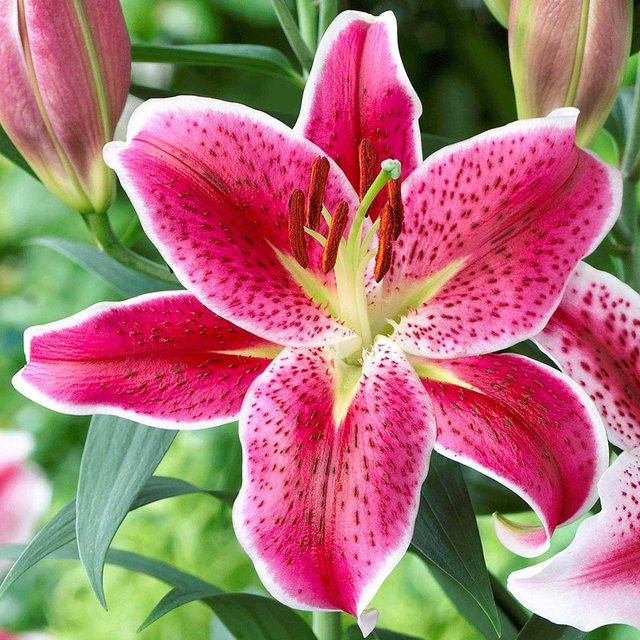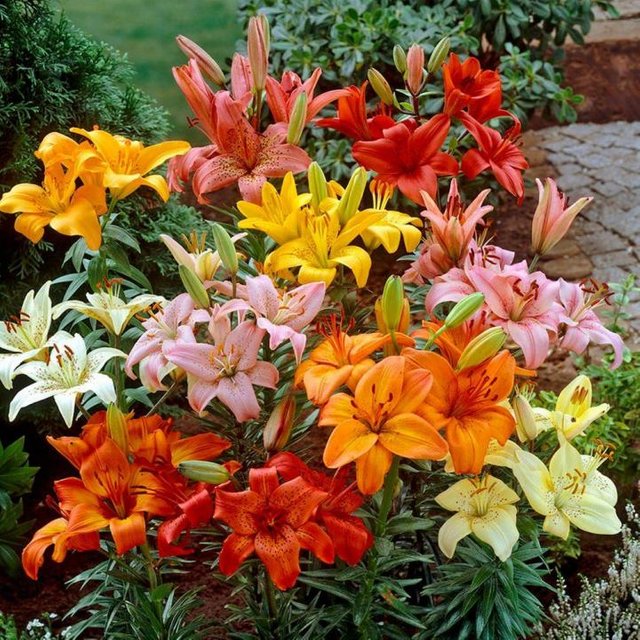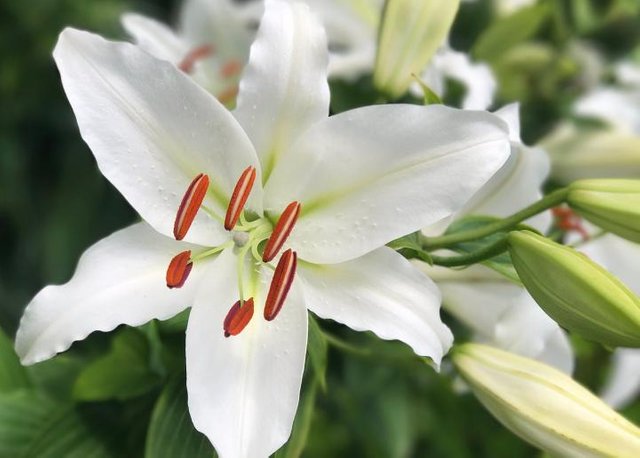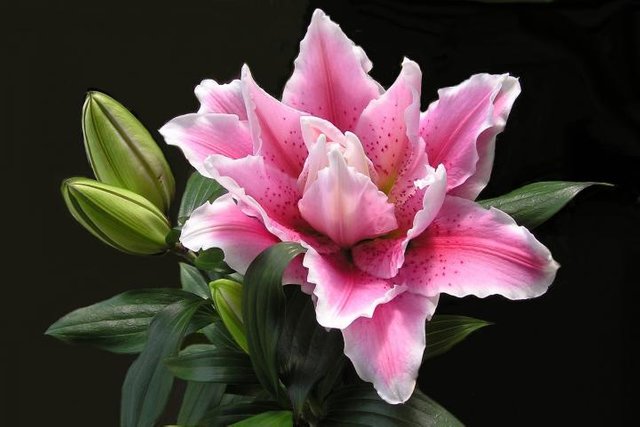Lilies flowers

How to Plant, Grow, and Care for Lilies
With colorful, star-shaped flowers, lilies give star power to summer gardens. Although it’s best to plant these bulbs in late summer, you can also plant them bulbs in spring once the ground is workable. Learn more in our Lilies Growing Guide.
About Lilies
Lilies add graceful elegance and fragrance to any garden, blooming from early summer all the way through fall, depending on the type. By carefully blending early, mid-season, and late varieties into your garden, you will enjoy their magnificent blooms from spring through first frost. At home in both formal and naturalistic settings, most lilies also take readily to containers. Plus, they make great cut flowers!
Lilies have six plain or strikingly marked tepals (“petals”) and are often trumpet-shaped, sitting atop a tall, erect stem with narrow, long, lance-shaped leaves. They come in many beautiful colors, including pink, gold, red, orange, and white.
There are a number of popular lily species, including Orientals, Asiatics, Orienpets, and Species types. To create a sequence of Lily blooms in your garden, keep in mind that Asiatics generally flower first followed by Orienpets and then Oriental varieties.
Asiatic lilies (Lilium sp. - “Asiatic hybrids”) bloom first in early summer (usually in May or June), right after peonies. They are not fussy as long as they are grown in well-draining soil. They are the shortest type of lily (about 2 to 3 feet tall) and come in many colors, from pastel to tropical. They don’t have much of a fragrance, but they do add bright color to the garden.
Easter lilies (Lilium longifolium) are most commonly grown indoors as a holiday plant. As their name suggests, they are typically forced into bloom around Easter, in March or April. Outdoors, they are better suited for warmer regions of North America, where they can be planted in the garden after blooming has finished.
Oriental lilies (Lilium sp. - “Oriental hybrids”) have that famously strong fragrance. They are tall and stately (4 feet), and tend to grow more slowly, often blooming about the time when Asiatic lily flowers are fading (mid- to late-summer).
Trumpet lilies (Lilium sp. - “Trumpet hybrids”) are similar to oriental lilies, producing many blooms with a nice scent. Their flowers tend to be smaller and more closed (like a trumpet) than those of the other lilies.
There are other lilies out there, of course, such as tiger lilies (Lilium henryi) and Turk’s cap lilies (Lilium superbum), as well as hybrids like “Orienpet” (Oriental + Trumpet) and “LA” lilies (Easter + Asiatic). Browse through your favorite online gardening retailer’s catalog to find what you like best!
Get to Know the “True Lilies”
In addition to there being many types of lilies, there are also many plants with “lily” in the name—and most are not “true lilies!” True lilies grow from onion-like bulbs and are of the genus Lilium.
Daylilies (Hemerocallis spp.), despite the similar appearance of their flowers, are not true lilies. Daylilies have many leaves that grow from a crown, whereas true lilies generally have only one stem or shoot that grows from a bulb. Similarly, peace lilies, canna lilies, water lilies, lily-of-the-valley, and calla lilies are not true lilies either! Learn more about what makes a lily a lily.

Lilies come in a range of bright, beautiful colors
PLANTING
Lilies need lots of sun. For dependable blooms, lilies should get 6 to 8 hours of direct sunlight a day (aka “full sun”). If it’s too shady, the stems will attempt to lean towards the sun or get spindly and fall over.
Select a planting site with soil that drains well. How can you tell? After a good rain, find a spot that is the first to dry out. Water trapped beneath the overlapping scales on the lily bulb may cause rot, so a well-drained site is essential. Enrich the soil with leaf mold, compost, or well-rotted manure to encourage good drainage. Learn more about soil amendments and preparing soil for planting.
Most of the popular varieties prefer acidic to neutral soil, but some are lime-tolerant or prefer alkaline soils (e.g., Madonna lilies).
When to Plant Lilies
In most regions, plant lily bulbs in the fall, at least four weeks prior to your first fall frost date. Bulbs planted in the autumn will have well established roots in the spring. The bulbs benefit from a winter chill to produce big blooms.
In areas with particularly harsh winters, consider planting in the spring instead. Plant as soon as the threat of frost has passed.
Container-grown lily plants can be planted anytime during the early summer.
Buy the bulbs close to planting time. Because lily bulbs don’t go dormant, they will deteriorate over time, so don’t plan to buy bulbs in the fall and wait until spring to plant them.

How to Plant Lilies
Loosen the soil to a depth of 12 to 15 inches.
Plant the bulbs 3 times as deep as the height of the bulb and set the bulb in the hole pointy side up. The deep planting encourages the developing stem to send out roots to help stabilize the plant and perhaps eliminate the need for staking. Also, deep planting keeps lily bulbs cool when temperatures soar.
Fill the hole with soil and tamp gently.
Space bulbs at a distance equal to three times the bulb’s diameter (usually about 8 to 18 inches apart, depending on the variety).
For visual appeal, plant lilies in groups of 3 to 5 bulbs.
Water thoroughly at time of planting.
GROWING
How to Care for Lilies
During active growth, water freely—especially if rainfall is less than 1 inch per week.
Keep lilies mulched so that their roots are cool. The mulch should feel moist, but not wet. Read more about mulching.
Apply a high-potassium liquid fertilizer every 2 weeks from planting until 6 weeks after flowering.
Apply a thin layer of compost each spring, followed by a 2-inch layer of mulch.
Stake tall lilies.
Lilies do not bloom more than once per season, but you can remove the faded flowers so that the plants don’t waste energy making seeds.
After the lily blooms, you can also remove just the stem itself. However, do NOT remove leaves until they have died down and turned brown in fall. It’s very important not to cut back the leaves until the end of their season because hey help provide nourishment to the bulb for next season’s blooms.
Cut down the dead stalks in the late fall or early spring.
Before winter, add 4 to 6 inches of mulch, simply to delay the ground freeze and allow the roots to keep growing. Leave the mulch until spring once the last hard frost has passed. See your local frost dates. See your local frost dates.
If your region doesn’t have snow cover, keep soil moist in winter.
When lily shoots grow through the mulch in the spring, start to remove it gradually.
Divide plants every 3 to 4 years as new growth begins in the spring. Just lift the plants and divide the clumps. Replant the new bulbs adding some compost.

Your complete post is just copied from here: https://www.almanac.com/plant/lilies
This is considered as plagiarism and not welcome in steemit community